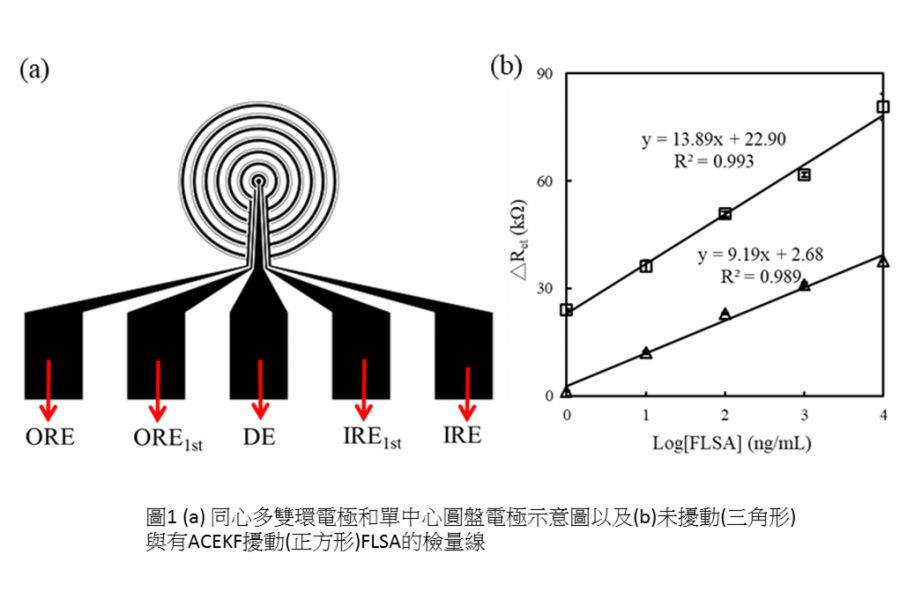| 論文篇名 | 英文:An impedimetric bioaffinity sensing chip integrated with the long-range DC-biased AC electrokinetic centripetal vortex produced in a high conductivity solution 中文:整合在高導電度溶液中產生長距離直流偏壓-交流電動向心渦流於阻抗式生物親和性感測晶片 |
| 期刊名稱 | BIOMICROFLUIDICS |
| 發表年份,卷數,起迄頁數 | 2018, 12, 044102 |
| 作者 | Ming-Jie Lin, Yen-Fu Liu, and Ching-Chou Wu*(吳靖宙) |
| DOI | 10.1063/1.5040231 |
| 中文摘要 | 抗原特異性鍵結到抗體的免疫反應常被廣泛使用眾多免疫分析應用,然而在靜止溶液中以擴散傳輸為主,會導致限制免疫反應的鍵結數量以及速率。本研究描述一晶片式同心多雙環電極和單中心圓盤電極晶片的建構,將一 1 VDC 6 Vpp電壓施加於多雙環電極,以誘發長距離直流偏壓交流電動流體(AC electrokinetic flow, ACEKF),免疫反應以電化學阻抗頻譜(electrochemical impedance spectrum, EIS)進行定量,將標定螢光物質二抗(Fluorescence-labeled secondary antibody, FLSA)以及蛋白質A作為免疫感測模型,驗證ACEKF對免疫反應效率的影響。結果顯示在ACEKF擾動下,FLSA達到鍵結飽和量僅需8分鐘,在液體擾動下電子轉移阻抗的增加量是大於未擾動溶液的2.26倍,有ACEKF擾動的檢量線靈敏度是大於未擾動溶液的1.51倍。整合長距離直流偏壓ACEKF擾動於免標定式EIS感測晶片,可有效提升免疫反應效率,有利於發展一微小化且快速檢測的體外診斷裝置 |
| 英文摘要 | Immunoreaction of specific antibodies to antigens is widely used in numerous immunoanalysis applications. However, diffusion-dominated transport in stationary solutions limits the rate and binding density of immunoreaction. This research describes the construction of chip-type concentric multi-double ring electrodes and single central disk electrode. A 1 V-biased 6 Vpp voltage was applied to the multi-double ring electrodes to induce a long-range DC-biased AC electrokinetic flow (ACEKF). The immunoreaction was quantified by electrochemical impedance spectrum (EIS). Fluorescence-labeled secondary antibody (FLSA) and protein A were exemplified as an immunoreacting model to demonstrate the effect of ACEKF on immunoreaction efficiency. The results showed that FLSA binding can reach a plateau in 8 min with the DC-biased ACEKF vortex, and the increment of electron transfer resistance is 2.26 times larger than that obtained in the unstirred solution. The sensitivity of the calibration curves obtained by EIS detection with the aid of DC-biased ACEKF vortex is 1.51 times larger than that obtained in an unstirred solution. The label-free EIS-based sensing chip integrated with the long-range DC-biased ACEKF vortex promises to facilitate immunoreaction efficiency, which is beneficial for the development of a miniature and fast-detection in vitro diagnostic device. |
n impedimetric bioaffinity sensing chip integrated with the long-range DC-biased AC electrokinetic centripetal vortex produced in a high conductivity solution 2018-07-06

設施農業:智慧感測【生物產業機電工程學系吳靖宙教授】






